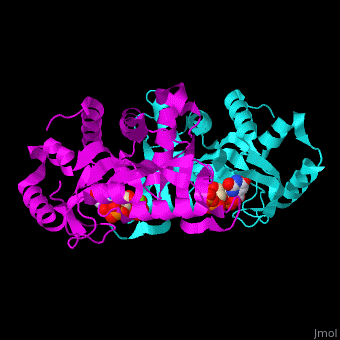Phosphoribosyltransferase
From Proteopedia
(Difference between revisions)
| Line 3: | Line 3: | ||
'''Phosphoribosyltransferase''' (PRT) are transferases which belong to several classes: <br /> | '''Phosphoribosyltransferase''' (PRT) are transferases which belong to several classes: <br /> | ||
1. '''Hypoxanthine-guanine PRT''' (HPRT). HPRT is part of the purine biosynthesis and catalyzes the formation of GMP from guanine, xanthosine monophosphate from xanthosine and of IMP from hypoxanthine and phosphoribosyl pyrophosphate ('''PRPP''')<ref>PMID:1487231</ref>. <br /> | 1. '''Hypoxanthine-guanine PRT''' (HPRT). HPRT is part of the purine biosynthesis and catalyzes the formation of GMP from guanine, xanthosine monophosphate from xanthosine and of IMP from hypoxanthine and phosphoribosyl pyrophosphate ('''PRPP''')<ref>PMID:1487231</ref>. <br /> | ||
| - | 2. '''Orotate PRT''' (OPRT). OPRT is part of the pyrimidine biosynthesis and catalyzes the formation of orotidine 5’-monophosphate (OMP) from orotate and phosphoribosyl pyrophosphate (PRPP)<ref>PMID:18020427</ref>. <br /> | + | 2. '''Orotate PRT''' (OPRT). OPRT is part of the pyrimidine biosynthesis and catalyzes the formation of orotidine 5’-monophosphate (OMP) from orotate and phosphoribosyl pyrophosphate (PRPP)<ref name="Gonza">PMID: 18020427</ref>. <br /> |
3. '''Quinolinic acid PRT''' (QAPRT ). QAPRT is a degrading enzyme found in the brain<ref>PMID:3159462</ref>. <br /> | 3. '''Quinolinic acid PRT''' (QAPRT ). QAPRT is a degrading enzyme found in the brain<ref>PMID:3159462</ref>. <br /> | ||
4. '''Uracil PRT''' (UPRT). UPRT catalyzes the formation of UMP from uracil and PRPP. Adenine PRT (APRT). APRT catalyzes the formation of AMP from adenine and PRPP<ref>PMID:9247925</ref>. <br /> | 4. '''Uracil PRT''' (UPRT). UPRT catalyzes the formation of UMP from uracil and PRPP. Adenine PRT (APRT). APRT catalyzes the formation of AMP from adenine and PRPP<ref>PMID:9247925</ref>. <br /> | ||
| Line 19: | Line 19: | ||
== Structural highlights == | == Structural highlights == | ||
| - | The structure of the yeast OPRT contains the two reaction products: <scene name='52/525122/Cv/5'>orotate</scene> and <scene name='52/525122/Cv/11'>PRPP</scene><ref | + | The structure of the yeast OPRT contains the two reaction products: <scene name='52/525122/Cv/5'>orotate</scene> and <scene name='52/525122/Cv/11'>PRPP</scene><ref name="Gonza" />. <scene name='52/525122/Cv/10'>Whole binding site</scene>. |
</StructureSection> | </StructureSection> | ||
Revision as of 09:24, 24 August 2018
| |||||||||||
3D structures of phosphoribosyltransferase
Updated on 24-August-2018
References
- ↑ Sculley DG, Dawson PA, Emmerson BT, Gordon RB. A review of the molecular basis of hypoxanthine-guanine phosphoribosyltransferase (HPRT) deficiency. Hum Genet. 1992 Nov;90(3):195-207. PMID:1487231
- ↑ 2.0 2.1 Gonzalez-Segura L, Witte JF, McClard RW, Hurley TD. Ternary complex formation and induced asymmetry in orotate phosphoribosyltransferase. Biochemistry. 2007 Dec 11;46(49):14075-86. Epub 2007 Nov 20. PMID:18020427 doi:10.1021/bi701023z
- ↑ Foster AC, Whetsell WO Jr, Bird ED, Schwarcz R. Quinolinic acid phosphoribosyltransferase in human and rat brain: activity in Huntington's disease and in quinolinate-lesioned rat striatum. Brain Res. 1985 Jun 17;336(2):207-14. PMID:3159462
- ↑ Carter D, Donald RG, Roos D, Ullman B. Expression, purification, and characterization of uracil phosphoribosyltransferase from Toxoplasma gondii. Mol Biochem Parasitol. 1997 Aug;87(2):137-44. PMID:9247925
- ↑ . PMID:121011881
- ↑ Castell A, Short FL, Evans GL, Cookson TV, Bulloch EM, Joseph DD, Lee CE, Parker EJ, Baker EN, Lott JS. Substrate capture mechanism of Mycobacterium tuberculosis anthranilate phosphoribosyltransferase provides a mode for inhibition. Biochemistry. 2013 Jan 30. PMID:23363292 doi:http://dx.doi.org/10.1021/bi301387m
- ↑ Pedreno S, Pisco JP, Larrouy-Maumus G, Kelly G, de Carvalho LP. Mechanism of feedback allosteric inhibition of ATP phosphoribosyltransferase. Biochemistry. 2012 Oct 9;51(40):8027-38. doi: 10.1021/bi300808b. Epub 2012 Sep, 27. PMID:22989207 doi:http://dx.doi.org/10.1021/bi300808b
- ↑ Galassi L, Di Stefano M, Brunetti L, Orsomando G, Amici A, Ruggieri S, Magni G. Characterization of human nicotinate phosphoribosyltransferase: Kinetic studies, structure prediction and functional analysis by site-directed mutagenesis. Biochimie. 2012 Feb;94(2):300-9. doi: 10.1016/j.biochi.2011.06.033. Epub 2011 Jul, 3. PMID:21742010 doi:http://dx.doi.org/10.1016/j.biochi.2011.06.033
- ↑ Imai S. Nicotinamide phosphoribosyltransferase (Nampt): a link between NAD biology, metabolism, and diseases. Curr Pharm Des. 2009;15(1):20-8. PMID:19149599
- ↑ Tohyama J, Nanba E, Ohno K. Hypoxanthine-guanine phosphoribosyltransferase (HPRT) deficiency: identification of point mutations in Japanese patients with Lesch-Nyhan syndrome and hereditary gout and their permanent expression in an HPRT-deficient mouse cell line. Hum Genet. 1994 Feb;93(2):175-81. PMID:8112742
- ↑ Montecucco F, Cea M, Cagnetta A, Damonte P, Nahimana A, Ballestrero A, Del Rio A, Bruzzone S, Nencioni A. Nicotinamide phosphoribosyltransferase as a target in inflammation- related disorders. Curr Top Med Chem. 2013;13(23):2930-8. PMID:24171767

